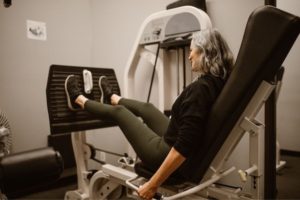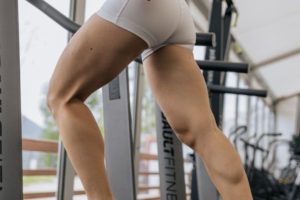Being pregnant brings many changes to your body and mind. If you’re pregnant and consider whether it’s safe to do leg presses while pregnant, this article is for you.

We’ll discover the potential risks and benefits involved.
But before we start, remember that every pregnancy is different, so it’s important to talk to your doctor before starting any exercise routine.
Let’s investigate this topic and learn more about leg presses during pregnancy.
Can I Do Leg Press While Pregnant?
The leg press is a type of exercise that targets your leg muscles, like your thighs and glutes. To do this exercise, you must sit on a machine and push a weighted platform away from your body using your legs.
This will help you strengthen and tone your legs while improving overall fitness. But what if you’re pregnant? Can you do leg presses while pregnant? Let’s find out!
During pregnancy, it’s important to prioritize your health and safety, including when it comes to exercise.
The leg press is a weightlifting exercise that involves pushing a platform away from your body using your legs.
While it can be beneficial for strengthening your lower body, it’s essential to consider certain factors before engaging in any exercise, including the leg press, during pregnancy.
Firstly, it’s crucial to consult with your healthcare provider before starting or continuing any exercise regimen while pregnant.
They will be able to evaluate your situation, considering any potential risks or complications you may have during pregnancy.
Assuming you have received approval from your healthcare provider, there’s a list of key factors to consider regarding doing leg press exercises while pregnant:
Balance and Stability
As your body changes during pregnancy, your balance and stability may be affected due to hormonal changes and the additional weight you carry.
The leg press requires proper form and balance to perform the exercise safely.
If you feel unsteady or have difficulty maintaining balance, avoiding the leg press may be best, and choose alternative exercises that provide stability, such as squats or lunges.
Abdominal Pressure
The leg press exercise places significant pressure on your abdominal muscles, potentially increasing intra-abdominal pressure.
This increased pressure may not be ideal during pregnancy, especially if you have conditions like diastasis recti (separation of abdominal muscles) or pelvic floor dysfunction.
It’s important to listen to your body and avoid exercises that cause discomfort, pain, or undue pressure on your abdomen.
Joint Stress
The leg press primarily targets the muscles of the lower body, including the quadriceps, hamstrings, and glutes.
While these muscles can be safely exercised during pregnancy, it’s crucial to be mindful of the stress placed on your joints, especially the knees and hips.
The hormone relaxin, released during pregnancy, can make your joints more flexible and susceptible to injury.
Ensure you use proper form, avoid excessive weight, and listen to your body’s signals to avoid placing unnecessary stress on your joints.
Breathing and Oxygenation
During pregnancy, your body changes the respiratory system to support the growing fetus. As your baby grows, the diaphragm and lungs may have less space to expand fully.
Exercises that require breath-holding or cause shortness of breath may not be recommended during pregnancy.
If the leg press exercise makes breathing challenging, choosing exercises that allow for proper breathing may be best.
In conclusion, the decision to do leg press exercises while pregnant should be made in consultation with your healthcare provider.
They can assess your condition, consider pregnancy-related risks or complications, and provide personalized guidance.
Can I Do A Seated Leg Press While Pregnant?

When doing seated leg press exercises while pregnant, you should proceed cautiously and consider a few key factors.
First and foremost, consult with your healthcare provider before engaging in any exercise routine during pregnancy.
They can offer personalized guidance based on your specific situation.
Seated leg press machines can provide better stability than normal leg press exercises. However, be mindful of maintaining proper form and balance throughout the exercise.
Pregnancy can affect your balance and stability due to changes in your body’s shape and center of gravity.
Consider the pressure exerted on your abdomen during seated leg press exercises. While it may be less than traditional leg press exercises, pay attention to your comfort level.
If you experience discomfort or excessive pressure on your abdomen, choosing alternative exercises that minimize abdominal pressure may be best.
Additionally, be mindful of the stress on your joints, particularly the knees and hips. Use proper form, avoid excessive weight, and listen to your body’s signals.
If you feel any joint pain or discomfort, consider adjusting the seat position and range of motion or opting for alternative exercises that are more comfortable for your joints.
Remember to focus on proper breathing during the exercise. Ensure you can comfortably inhale and exhale without holding your breath.
Avoid breath-holding or overexertion, which can compromise oxygenation and increase discomfort.
In summary, consult your healthcare provider for personalized advice, pay attention to balance and stability, be mindful of abdominal pressure and joint stress, and prioritize proper breathing.
Always listen to your body and adjust or choose alternative exercises to ensure your safety and well-being during pregnancy.
Benefits of Leg Press During Pregnancy
Leg press exercise can provide several benefits for pregnant women if done correctly and with proper modifications. Some of the benefits include:
1. Stronger Leg Muscles
Leg presses can strengthen your quadriceps, hamstrings, and glutes, supporting your growing belly, improving your posture, and reducing pregnancy discomfort.

2. Better Stability and Balance
Pregnancy can affect your balance due to weight changes. Leg presses can help improve your lower body stability, reducing the risk of falls or injuries.
3. Improved Cardiovascular Fitness
Doing leg presses in a controlled way can raise your heart rate and improve your cardiovascular fitness, which is important for your overall health during pregnancy.
Potential Risks and Precautions
While leg presses can be beneficial during pregnancy, they come with risks you must consider, such as the following:
1. Joint Looseness and Injury
Pregnancy hormones can make your joints looser, increasing the risk of injury. Be careful not to use too much weight or strain your joints during leg press exercises.
2. Avoid Overheating and Fatigue
Pregnancy already increases your body temperature, and intense exercise can make it higher. Make sure not to overheat and take enough breaks and rest between sets.
3. Using Proper Form and Breathing
It’s important to maintain proper form during leg press exercises to avoid straining your muscles or putting too much pressure on your pelvic area. Focus on breathing properly to support your core stability.
4. Listening to Your Body
Every pregnancy is different, so what works for someone else may not work for you.
Therefore, you must pay attention to your body’s signals and modify or stop exercises if you feel pain, dizziness, shortness of breath, or other symptoms.
Conclusion
Exercise is a key part of a healthy pregnancy. However, taking care of yourself in various ways, like resting, proper nutrition, hydration, stress control, and pelvic floor exercises, also matters.
Prioritize your safety and health, and listen to your body when deciding whether to do leg presses or any other exercises during pregnancy.
While leg presses can be beneficial with the right modifications, consulting with your healthcare provider first is crucial.
Consider alternative exercises like squats, lunges, prenatal yoga, or water workouts if leg presses don’t feel right for you.
Ultimately, the goal is to stay active within your limits and enjoy a healthy and fulfilling pregnancy journey. Embrace the pregnancy journey with care, and remember that staying healthy and happy is key.

When I was in high school, I was the best at running. Running for me is not a trend, this is my whole life. I jog every morning, without exceptions: I don’t skip mornings on vacations or business trips. My friends are also sports fans: I went to my best friend’s yoga class for the first time about three years ago.
Since then, I’ve been practicing regularly, and we have also made several yoga trips to India. For my last birthday, I got a skateboard as a present from her. Now we’re both taking personal classes with a coach, and it’s 100% fun!





